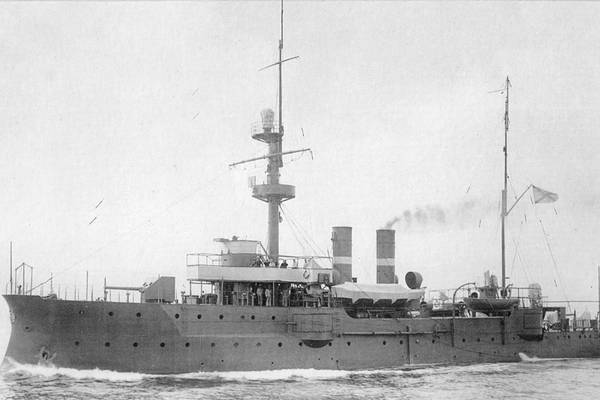“Baltic Varyag” is not surrendering to the enemy

19 August 1915, the crew of the gunboat "Sivuch" repeated the feat of the cruiser "Varyag"
For Russia, hostilities in the spring and summer of 1915 in the western direction were unsuccessful. Germany significantly strengthened the Eastern grouping, as a result, the enemy forces managed to break through the Russian front and occupy part of the Russian territories. We left Poland, Galicia, Kurland (part of modern Latvia). The enemy troops reached the Gulf of Riga, and the front came close to Riga.
To support the Sloki detachment, which held the defense of Riga and at the same time had practically no artillery, the command sent gunboats Sivuch and Koreets. Together with other Baltic ships fleet they participated in joint hostilities with the ground forces of the Riga fortified area and provided significant support to the infantry.
The German military leadership to speed up the operation to seize Riga sent a squadron of ships to the Gulf of Riga to eliminate the Russian naval forces stationed in the gulf and preventing the capture of the city.
An attempt to break into the 8 Gulf on August 1915 of the year for 7 German battleships, 6 cruisers, 24 destroyers and 14 minesweepers was unsuccessful. The Russian forces were much smaller, but the battleship Slava, gunboats Sivuch, Brave and Ghost, mine-laying Amur and 16 destroyers prevented the German squadron from passing through the Irben Strait.
In the following days, the Germans securely covered their minesweepers, who cleared minefields in the strait. The forces defending the Gulf of Riga gave heroic resistance to the Germans who were pushing, knocked the enemy out of the offensive schedule, but as the captain of 2 rank George Stark clearly noted, “we cannot hold our position with our forces, it’s just a matter of time”.
By August 18, the Germans had struck a strip of minefields and destroyed the anti-submarine network. By this time, all the ships retreated to the Moonsund base, their further stay in the bay was extremely dangerous. Only "Sivuch" and "Korean" continued to work on the installation of mines. The order to leave the Gulf of Riga sounded too late when the enemy ships already entered the bay. The chance to get out of it by the commander of the Korey, captain of the 2 rank Ivan Fedyaevsky, was assessed as one out of a hundred.
Fedyaevsky and the commander of Sivuch, captain of 1 rank Peter Cherkasov, made a decision “in case of death from a submarine, do not take other people off the ship; in the case of a meeting with a stronger and more numerous enemy, do not hold together ”.
The 6 (19) of August, the gunboats left the port of the Ust-Dvinsk fortress, until the evening they managed to take a course to the north, remaining unnoticed. However, at about nine o'clock they found the approaching German ships: the cruiser "Augsburg" and two destroyers.
The enemy ships were faster and better armed, in the sum of 17 German guns against the 12 Russians. Collisions could not be avoided, “Korean” with “Sivuch”, having developed the maximum speed, tried to leave. The Germans joined in the pursuit, while reducing the distance from the onboard guns, they opened fire, and the destroyers fired torpedoes. From the torpedoes, the candelds dodged, but the German artillery took out the Sivuch and smashed the feeding implements.
The Koreans managed to knock down the nasal searchlight from the Ausburg and, when darkness fell, move away. The withdrawal of the Korean was covering the Sivuch, it took over the full power of the German cruiser’s fire, which was soon joined by the German destroyers and the battleships Posen and Nassau.
The Sivuch did damage to the Augsburg and the destroyer, but the forces were too unequal. The ship turned into a flaming torch, the boat lost speed and began to sink into the water. In such conditions, midshipman Mikhail Murzin continued to fire at the enemy from the only surviving weapon.
The last news, which was sent by the commander of the ship Pyotr Nilovich Cherkasov, reported: "I perish, but I do not give up."
Sivuch sank off Cuneau Island (now Estonia). The Germans picked up the surviving sailors and helped them. 98 seafarers, along with captain Cherkasov, were killed; 50 seafarers died from wounds among the selected 8. Peter Cherkasov was posthumously promoted to captain of 1 rank and awarded the Order of St. George 4 degree.
The very one of a hundred cases that Captain Fedyavsky spoke about fell out to the crew of his ship. The Koreyian ran aground and the next day, so that the ship would not get to the enemy, the commander decided to blow it up. Captain Fedyavsky did not possess information that the Germans were leaving the gulf. The German squadron, methodically making its way into the Gulf of Riga, left 20 in August.
What made change the plans of the German command? One of the factors was the stubbornness of the Russians, with small forces they disrupted the offensive schedule, destroyed and destroyed several German ships.
The Sivuch, like the Koreets, was originally built for the Amur military flotilla, and they were named after the ships participating in the Russian-Japanese war. The Sivucha team, led by captain Peter Cherkasov, accomplished a feat equal to the feat of the crew of the famous Varyag, therefore this gunboat is called the “Baltic Varyag”. The feat of Russian sailors and officers will remain forever in stories.
Information